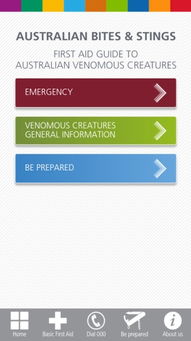When Treating Bites and Stings, You Should Use the Right Approach
Dealing with bites and stings can be a daunting task, especially when the reaction is severe. Knowing the right steps to take can make a significant difference in managing the situation effectively. Whether it’s a bee sting, a spider bite, or a jellyfish sting, here’s a detailed guide on what you should use when treating these common injuries.
Identifying the Type of Bite or Sting

Before you can treat a bite or sting, it’s crucial to identify the source. This helps in understanding the potential severity of the reaction and the appropriate treatment. Here’s a quick guide to help you identify the type of bite or sting:
| Type of Bite/Sting | Source | Common Symptoms |
|---|---|---|
| Bee Sting | Bee | Pain, redness, swelling, itching, and sometimes a rash |
| Spider Bite | Spider | Variety of symptoms depending on the type of spider, ranging from mild to severe |
| Jellyfish Sting | Jellyfish | Pain, redness, swelling, and sometimes a rash or blisters |
Remember, some spider bites can be life-threatening, so it’s essential to seek medical attention if you’re unsure about the source or if symptoms are severe.
Immediate First Aid

Once you’ve identified the type of bite or sting, here are some immediate first aid steps you should take:
-
Remove the stinger if it’s still in the skin. For bees, scrape it out with a credit card or your fingernail; for jellyfish, use a towel or gloved hand to remove the tentacles.
-
Rinse the area with cool, clean water to remove any venom and debris.
-
Apply a cold compress to reduce swelling and pain. A bag of ice wrapped in a cloth works well.
-
Bandage the area to protect it from further injury.
Over-the-Counter Remedies

After the immediate first aid, you can use over-the-counter remedies to alleviate symptoms:
-
Antihistamines: These can help reduce itching and swelling. Look for products containing diphenhydramine or cetirizine.
-
Topical creams: Products like hydrocortisone cream can help reduce inflammation and itching.
-
Oral pain relievers: Over-the-counter pain relievers like ibuprofen or acetaminophen can help manage pain.
Home Remedies
Some home remedies can also be effective in treating bites and stings:
-
Apple cider vinegar: Soak a cloth in apple cider vinegar and apply it to the affected area to help neutralize the venom.
-
Baking soda: Mix baking soda with water to create a paste and apply it to the sting to reduce swelling and itching.
-
Tea tree oil: Apply a few drops of tea tree oil to the bite or sting to help reduce inflammation and prevent infection.
When to Seek Medical Attention
While most bites and stings can be treated at home, there are certain situations where you should seek medical attention:
-
Severe pain or swelling that doesn’t improve after a few hours.
-
Difficulty breathing or swallowing.
-
Severe redness, swelling, or oozing from the bite or sting.
-
Signs of infection, such as fever, warmth, or pus.
-
Unusual symptoms, especially if you’re allergic to the source of the bite or sting.
By following these guidelines, you




